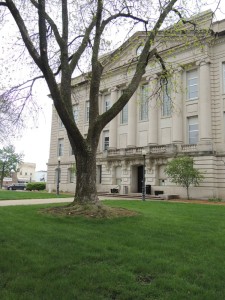
Drew Sorenson is known throughout the county as an astronomer looking out into the universe, but he spoke Monday with the Greene County board of supervisors about something firmly planted in the ground – the trees that surround the courthouse.
Sorenson is concerned about the two very large ash trees and the maple trees on the north side of the courthouse. “Those maples are old and broken, and I think that while we still have shade it might be a good idea to plant some trees so they get a good start,” he said.
Emerald ash borers have been found in Boone and southern Dallas counties, and the pace at which the infestation is spreading is accelerating.
The two largest trees on the courthouse square are ash trees. Conservation director Dan Towers and sanitation director Tim Healy are unsure how old the trees are. Both say they’re at least 80 years old, but it’s possible they were planted very soon after construction on the courthouse was completed in 1917.
Neither tree is very healthy, Healy said, although there is no evidence of EAB.
The courthouse trees were trimmed by Hoskinson Tree Service last Thursday. According to Healy, Keith Hoskinson reported the maple trees closer to State St are not healthy. “They don’t have a lot longer to live,” Healy said. Courthouse custodian Amy Chapman said the ash trees aren’t healthy and create a lot of work with the number of sticks that fall from them.
“This is a discussion we need to have,” supervisor Guy Richardson said, and suggested the supervisors appoint a committee.
“We need to plan ahead, to look at ideas of what might fit well,” board chair John Muir said.
The board had talked previously about having the ash trees treated against EAB but has not made a decision. Only ash trees are susceptible to EAB; the status of the maple trees is due to aging.
Many cities around the state are developing aggressive plans to address aging trees and EAB, either treating or removing trees on public property. The city of Jefferson plans to cut trees on city-owned property should an infestation occur. The county owns the courthouse property, putting the option and duty to care for the trees on the supervisors.
